-
Medical journals
- Career
Patients experiences after hospitalization at Gynecologic Obstetrics Department: Identifying parts for improvement
Authors: P. Drabiščáková; B. Balažovjechová; M. Križko jr.; Peter Papcun; P. Oťapková; J. Záhumenský
Authors‘ workplace: nd Department of Obstetrics and Gynecology, University Hospital Bratislava, Faculty of Medicine, Comenius University Bratislava, Slovakia, head of the department doc. MUDr. J. Záhumenský, PhD. 2
Published in: Ceska Gynekol 2020; 85(1): 59-66
Category: Retrospective study
Overview
Objective: Evaluation of the quality of the hospital care at individual departments of the clinic from the patient's perspective using a standard questionnaire.
Design: Retrospective observational studies.
Setting: 2nd Department of Obstetrics and Gynecology, University hospital Bratislava, Faculty of Medicine, Comenius University Bratislava, Slovakia.
Material and methods: In the study we included all patients who were hospitalized in II. GPK from 1. 1. 2019 to 1. 3. 2019. When the patient was released, they received a HCAHPS questionnaire. Obtained results were statistically processed and compared with publicly available data from all USA hospitals.
Results: We received 481 questionnaires suitable for processing. 53.2% of patients evaluated the clinic as the best possible. 57.4% of patients would definitely recommend the clinic to their family and friends. The biggest difference between patients who rated the clinic as the best and those who rated it low were in nurse communication (OR: 6.19, CI: 4.46–8.63). At maternity ward we haven't found any statistical effect in impact of age, but in nurses communication, pain management, communiation about medicines we found significant statistical differences in impact of different education between women.
Conclusion: The quality of nurses and doctors communication and instructing patients about medication has a significant impact on the clinic's evaluation. Women with university education at maternity ward evaluate quality of hospital care stricter, regardles of age.
Keywords:
Quality of care – HCAHPS questionnaire – obstetrics – patients experience
INTRODUCTION
In the last period, there is a strong public pressure in Slovakia to humanize obstetric services. The petition for humanization of obstetrics signed at the date of 1. 6. 2019 already 1644 people [18].
Monitoring the observance of human rights in obstetrics and respecting the care of a mother becomes a major topic of obstetric professional events and professional texts abroad [15]. The part of this medical care consist of relevant and respectful comunication by medical staff, disqisitional education and patient instruction, and pain control [3]. Patient satisfaction is also important coeficient in the quality of health care, such as an aplication of updated evidence based medicine. Excellence in medical care is measured by 3 metrics: lower costs, better outcomes, and better patient experiences [22]. There were developed several systemic questionnaire systems to monitor patient hospital experience.
The Hospital Consumer Assessment of Healthcare Providers and Systems (HCAHPS) questionnaire was developed in 2002 as a collaboration between Centers for Medicare & Medicare Services and the Agency for Healthcare Research and Quality and was implemented for reporting in October 2006 [1]. In the USA, the questionnaire has become a standard in monitoring patient hospital experience and is freely available on the internet [11]. It is the property of the USA government and no copyright is attached to it. Various language translations and modifications have been developed and the questionnaire is gradually being introduced in various countries of the world [16]. The aim of our study was to determine the satisfaction of our patients using the HCAHPS questionnaire and to compare our results with results in USA hospitals. We will use the results to develop better health care system to improve the quality of our care in our department.
MATHERIAL AND METHODS
Our study group consist of patients, who were hospitalized at II. Department of Obstetrics and Gynecology, Faculty of Medicine, Comenius University and University hospital Bratislava from 1. 1. 2019 to 1. 3. 2019. The patients received HCAHPS questionnaire in Slovak language, right before they were discharged from the hospitel. Exclusion criteria for our study were foreign speakers, patients hospitalized less than 48 hours, and from etic reasons women with dead fetus after II. trimester.
We put data in the Excell program and data were statistically processed by Medcalc. Cathegorical data were evaluated by using Fisher‘s test, continuous data were evaluated by t-test. The p <0.05 was determined as the significance level.
HCAHPS QUESTIONNAIRE
Our version of the questionnaire contained of 29 questions, 22 questions were part of the HCAHPS questionnaire and 7 questions were directly related to self-assessment of health, age, reason for hospitalization, education and nationality. If we wanted to evalluate our questionaire, we had to divide it in three types of evaluation.
Our questionaire is divided into more parts with multiple questions (for example, part focused on communication with nurses consists of 3 sub-questions). This part of questionaire evaluation calculated the ratio of positive responses to all sub - questions to the number of all modality responses.
Second part of evaluation included check colums with the most appropriate answer. Only a 100% satisfaction, is considered as a positive answer (for example: Question: During this hospitalization, how often did nurses take care of you with respect? Only a response always is considered as a positive answer).
The last one is the scale of rating of our department (0 – worst hospital to 10 – best hospital),only answers 9 and 10 were consider as possitive answers.
RESULTS
There were 1477 patients hospitalized at our clinic during the study period, of which short-term hospitalizations (less than 48 hours) were 384. Questionnaires were received by 780 patients, 528 of them were returned and 481 questionnaires were suitable (Figure 1). The reason why the questionaire wasn´t respondible for our study was received incopletely filled questionaire.
It shows a graphical distribution of the file by age, education, reason of hospitalization and department of our clinic where the patient was hospitalized (Figure 2).
It shows evaluation of each part of questionaire compared to data obtained from 3086 USA hospitals in year 2018 (Table 1).
1. Comparision of II. GPK Ružinov with values based on questionnaires from 3086 hospitals across the USA.(Source: http:// www.hcahpsonline.org. Centers for Medicare & Medicaid Services, Baltimore, MD. Juni, 6, 2019) 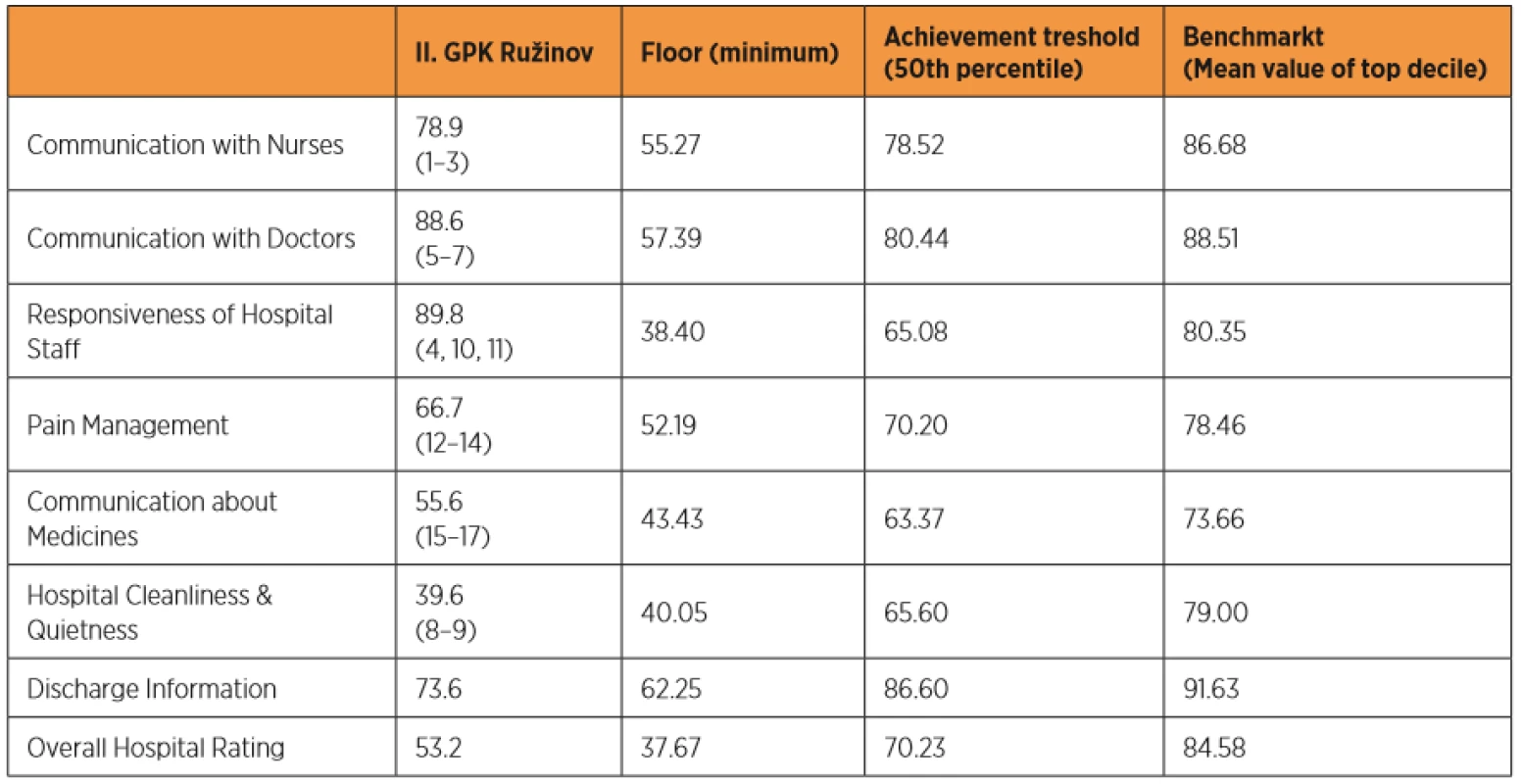
It shows a graphical answer to the question, whether a patient would recommend a hospital to family and friends (Figure 3).
It divide the evaluation of each part of questioner in two groups of patients who rated our clinic as the best 9 and 10 out of 10 possible and those who evaluated our clinic by 7 or less (Table 2)
2. Comparison of individual parts ratings in the patient group that rated the hospital as the best (9 and 10) and rated the hospital 7 and below 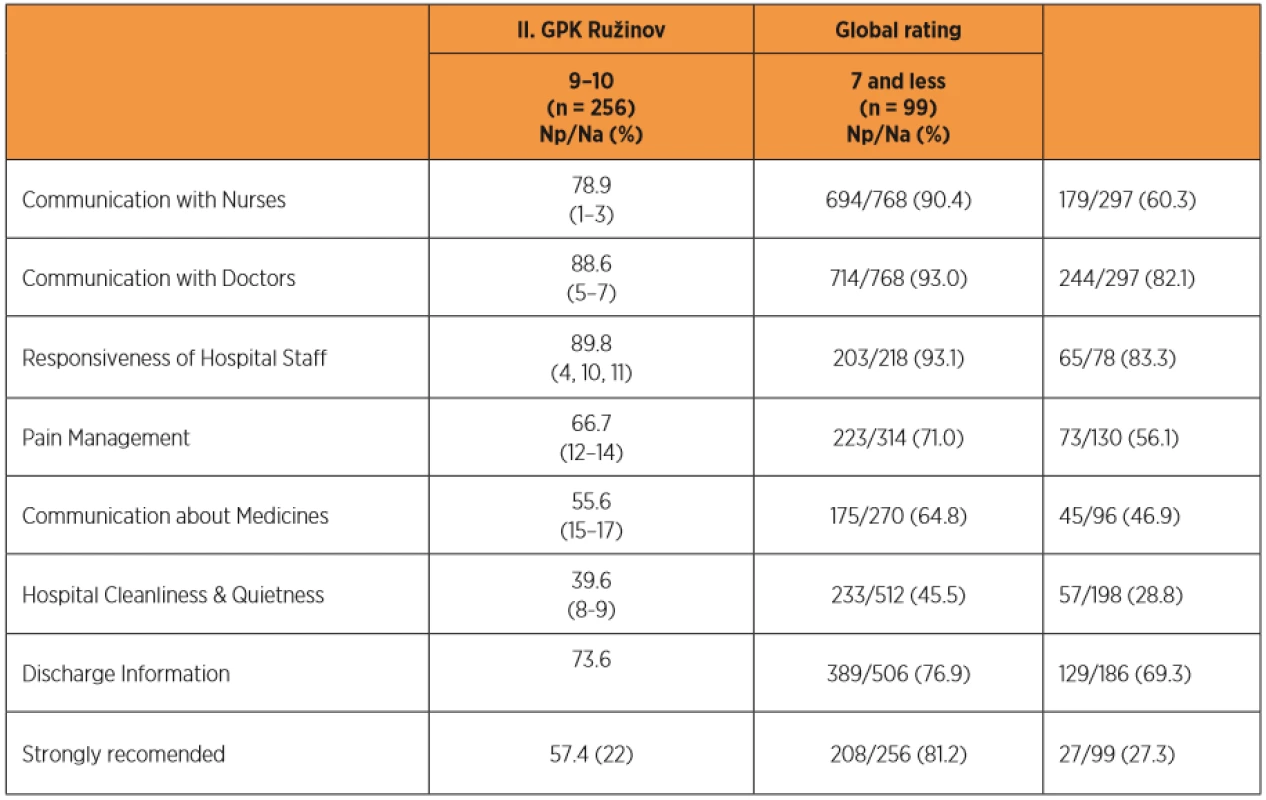
It compares rating by individual clinic department. This table compare evaluation based on the age and education of women hospitalized after baby-delivery on our clinic (Table 3, 4).
3. Comparison of patient evaluation at individual clinic departments 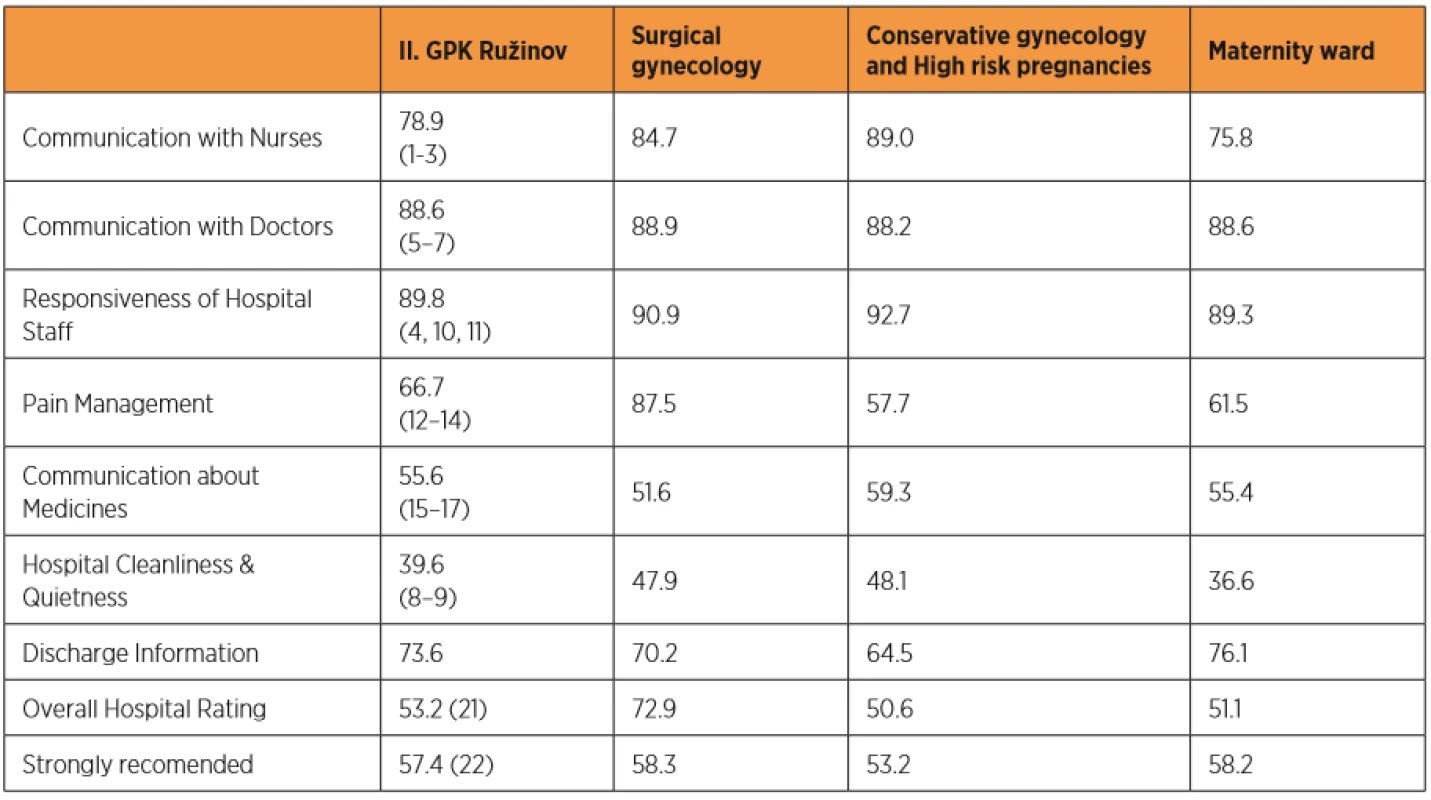
4. Analysis of the impact of age and education on the evaluation of individual parts 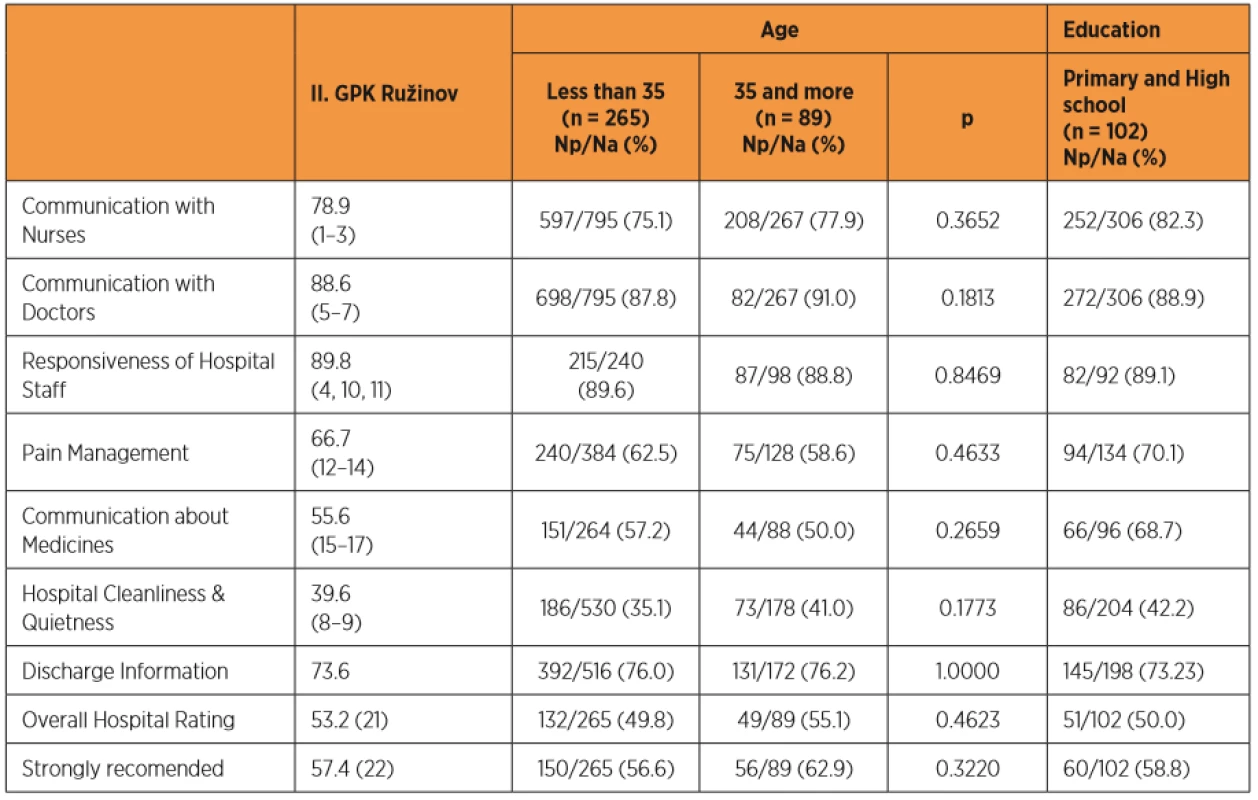
DISCUSION
Analysis of our institutional HCAHPS data from patients undergoing hospitalization identified action targets for quality improvement that could lead to better patient experience and also better patient outcomes. Patient satisfaction is unseparated part of global quality of healthcare. Highly HCAHPS evaluated departments also show better results in another parameters of health care quality [14]. There is even an indirect ratio between the HCAHPS evaluation and the hospital mortality [21]. Hospitals with excellent nurses and doctors comunication have a statistically higher readmission rate than lower-rated hospitals [24].
In the USA, there is also a patient evaluation of hospitals on the Facebook social network. This evaluation correlates with the score obtained the HCAHPS questionnaire [2].
Lower score of satisfaction in some of our monitored parts compared to global USA scores, we can partly explained by the purely female representation in our monitored group. Women are more strictly in evaluation and have statistically significantly lower satisfaction scores than men [6].
Overall, our clinic showed good results in nurses and doctors communications. In both of them, we achieved over the 50th percentile of hospitals in the USA. The best communication had nurses on the conservative gynecology department and high risk pregnancies department, the worst on maternity ward. It can be explained by the fact, that communication with mothers on maternity ward, provides by midwives and neonatal nurses, is very difficult and specific. On the other hand, communication with doctors was highly evaluated at all departments of our clinic, without significant differences. Gynecology and Obstetrics doctors shows the best patient-doctor communication compared to other specializations [7].
We had also high score in evaluation of responsivenes of hospital staff in our clinic. It achieved almost 90 points, which is significantly higher than achieved Benchmark in the USA. We are an acute department with short-term hospitalizations and most of our patients are fully mobile and self-sufficient. Short-term assistance requires only patients right after operation and mothers right after delivery. Our hospital staff is ready and responsive to these situations.
In the field of pain management, the situation in obstetrics departments is difficult. On our surgical gynecology we have achieved a high score in this area, significantly higher than Benchmark in the USA (87.5 vs 78.46). The maternity ward score was significantly lower, 57.7, it is probably related to the experience of childbirth pain, as well as bad management of childbirth pain. We will have to focus on this problem in the future. Training of nurses in department of puerperium significantly increased the administration of analgesics due to perineal pain by 27% and improved compliance of nurses in this area by 100% [25]. Except of analgesics it is also possible to apply local cooling like ice pack or cooling gel pads [5]. Equally simple is the administration of a non-steroidal analgesic in the form of a rectal suppository at the end of the wound treatment, this significantly reduce need for analgesia in the postpartum period [4]. Lower evaluation in departments of gynecology and high risk pregnancy could be explained by the fact, that there were a lot of inducted births. These women received insufficient analgesia at the begining of delivery. Similarly, on this department, hospitalized women with dolores praesagientes were also sensitive to painful contractions. This is another impulse for analysis how we can get better in pain management.
Our weak point was communication with the patient when new drugs were administrated. This phenomenon is common in surgical departments where the surgical part of therapy is emphasized [9, 12]. In the future we will have to focus on this and lead hospital staff to improvement of informed patients about administered drugs.
Surgical departments have also lower scores in provide instructions to the patients before discharge from the hospital. In study by Hanson et al. was the ratio of patient satisfaction with the instruction at discharge from the neurosurgical clinic of 0.55 versus those released from the neurological department [10]. In this part, our overall score was lower than was the average in USA hospitals. Maternity ward showed the highest score, followed by surgical gynecology and least departments of conservative gynecology and high risk pregnancies. Proper nurse training has the potential to increase the score in this part by up to 14% (from 84.6% to 98.6%) [20].
We had also low score in the part of hospital clearnines and quietnines. The score in this part was mostly reduced because of maternity ward. Mothers probably do not have enough nighttime rest because of rooming in and crying newborn babies. On the other two departments, the score was slightly better, but still on the USA level (floor). We have to admit that an external company provides cleaning services in our hospital and we are not always satisfied with the results of their work.
Overal hospital rating was a disappointment to us. We did not even achieve the achievement treshold from USA hospitals. We take this as a challenge to improvement in the future. Good result was on surgical gynecology, but conservative gynecology, high risk pregnancies and maternity ward had significantly lower score.
We divided our patients in two groups. First, patients who rated our clinic as the best 9 and 10 out of 10 possible and those who evaluated our clinic by seven or less. After that we calculated the odds ratio of each parts. The biggest difference was in the part of nurse communication, the odds ratio was up to 6.18 (CI: 4.43–8.63). It means, that women were the most satisfied in the part of nursing communication.
Other parts had lower odds ratio. The highest odds ratio was reported as comunication of doctors, 2.87 (CI: 1.91–5.09). These areas should be considered as priorities in increasing the ratio of hospital by patients in future. Iannuzzi et al. reported similar results, however odds ratio for sister comunication was rated as 10.33 (CI: 6.79–5.72) and the odds ratio for doctor comunication was 7.99 (5.09–12.54) [13].
The influence of quality assessment is possible in addition to direct communication during hospitalization also by quality preoperative preparation including a detailed explanation of the problem and possible postoperative development [19]. In gynecological surgery, the HCAHPS score is also affected by operative approach, in general, mini-invasive surgery methods improve patients evaluation of care quality [23].
Some studies have confirmed the dependance between the patient‘s age and HCAHPS score [8]. In our evaluation of age and education we were focused only on women in labour, because they represented sufficient number of respondents. If we evaluated the whole set of respondents, the different attitude of the staff at each department of the clinic would distort these results. In this study, we did not confirm the dependence of age.If we are talking about homogeneous group of patients (women in labour), the age does not play a significiant role in rating. The respondents of this study these patients comfirmed the dependence of evaluation in education. Women in labour with university degree had statistically lower score in several groups of our questionaire such as: communications with nurses, pain management and communication about medicines. In communication with doctors we didn’t find any diferences. Its possible, that women in labour with university degree are more challenging on behavior of middle medical stuff. Interesting thing about that is the fact that these major differences didn’t have impact on overall hospital rating and also on recomandation of hospital to family and close relatives. In study of Otani et al. have confirmed that higher education affects the assessment in all categories of HCAHPS questionnaire; and it has been even more pronounced by women than by men [17].
Our study is limited by its retrospective nature and single-institutional design. In addition, we were unable to assess nonresponse bias because we are unable to differentiate between patients who received a survey and did not return it and patients who were not sampled.
CONCLUSION
These results represent a clear guide to the areas, on which we should be focused on in future to improve the overall rating of our clinic. Comunication of nurses and doctors was evaluated on high level, nevertheless it strongly affects the overall evaluation and the highest risk is presented in maternity ward At maternity ward, we need to pay more attention to perineal pain and its treatment after childbirth. We also need to design an effective analgesic strategy for birth induction and women with dolores praesagientes in conservative gynecology and high risk pregnancies department. In all departments of our clinic we need to improve comunication to patients to explain them the use of medicaments used for their treatment.
It is neccessary to put our attention and make time to inform our patients when they are released from hospital on the department of conservative gynecology and high risk pregnancies. We need to pay more attention to the cleanliness of the bathrooms and toilets in all departments of the clinic.
Corresponding author:
doc. MUDr. Jozef Záhumenský, PhD.
2nd Department of Obstetrics and Gynecology
University Hospital
Ružinovská 6
826 06 Bratislava
Slovakia
e-mail: jozef.zahumensky@gmail.com
Sources
1. Bobrovitz. N., Santana, MJ., Kline, T., et al. Multicenter validation of the Quality of Trauma Care Patient-Reported Experience Measure (QTAC-PREM). J Trauma Acute Care Surg, 2016, 80(1), p. 111–118.
2. Campbell, L., Li, Y. Are Facebook user ratings associated with hospital cost, quality and patient satisfaction? A cross-sectional analysis of hospitals in New York State. BMJ Qual Saf, 2018, 27(2), p. 119–129.
3. Chen, JG., Zou, B., Shuster, J. Relationship between patient satisfaction and physician characteristics. J Patient Exp, 2017, 4(4), p. 177–184.
4. Dodd, JM., Hedayati, H., Pearce, E., et al. Rectal analgesia for the relief of perineal pain after childbirth: a randomised controlled trial of diclofenac suppositories. BJOG An Int J Obstet Gynaecol, 2004, 111(10), p. 1059–1064.
5. East, CE., Begg, L., Henshall, NE., et al. Local cooling for relieving pain from perineal trauma sustained during childbirth. Cochrane Database Syst Rev, 2012, (5):CD006304.
6. Elliott, MN., Lehrman, WG., Beckett, MK., et al. Gender differences in patients’ perceptions of inpatient care. Health Serv Res, 2012, 47(4), p. 1482–1501.
7. Erdman, J. Bioethics, human rights, and childbirth. Health Hum Rights, 2015, 17(1), E43–51.
8. Goldstein, E., Elliott, MN., Lehrman, WG., et al. racial/ethnic differences in patients’ perceptions of inpatient care using the HCAHPS survey. Med Care Res Rev, 2010, 67(1), p. 74–92.
9. Gurland, BH., Merlino, J., Sobol, T., et al. Surgical complications impact patient perception of hospital care. J Am Coll Surg, 2013, 217(5), p. 843–849.
10. Hanson, KT., Zalewski, NL., Hocker, SE., et al. At the intersection of patient experience data, outcomes research, and practice: analysis of HCAHPS scores in neurology patients. Mayo Clin proceedings Innov Qual outcomes.,2018, 2(2), p. 137–147.
11. HCAHPS. https://www.hcahpsonline.org/en/quality-assurance/. Accessed June 2, 2019.
12. Helder, MRK., Schaff, HV., Hanson, KT., et al. Patient experience after cardiac surgery: identifying areas for improvement. Ann Thorac Surg, 2019, 107(3), p. 780–786.
13. Iannuzzi, JC., Kahn, SA., Zhang, L., et al. Getting satisfaction: drivers of surgical Hospital Consumer Assessment of Health Care Providers and Systems Survey Scores. J Surg Res, 2015, 197(1), p. 155–161. doi:10.1016/j.jss.2015.03.045.
14. Jha, AK., Orav, EJ., Zheng, J., et al. Patients’ perception of hospital care in the United States. N Engl J Med, 2008, 359(18), p. 1921–1931.
15. Lokugamage, AU., Pathberiya, SDC. Human rights in child-birth, narratives and restorative justice: a review. Reproduct Health, 2017, 14(1), p. 17.
16. Orindi, BO., Lesaffre, E., Quintero, A., et al. Contribution of HCAHPS specific care experiences to global ratings varies across 7 countries. Med Care, 2019, p. 1.
17. Otani, K., Buchanan, PR., Desai, SP., et al. Different combining process between male and female patients to reach their overall satisfaction. J patient Exp, 2016, 3(4), p. 145–150.
18. www.peticie.com/porod. Accessed June 1, 2019.
19. Schmocker, RK., Cherney Stafford, LM., Siy, AB., et al. Understanding the determinants of patient satisfaction with surgical care using the Consumer Assessment of Healthcare Providers and Systems surgical care survey (S-CAHPS). Surgery. 2015, 158(6), p. 1724–1733.
20. Stikes, R., Arterberry, K., Logsdon, MC. A Nurse leadership project to improve health literacy on a maternal-infant unit. J Obstet Gynecol Neonatal Nurs, 2015, 44(5), p. 665–676.
21. Tevis, SE., Kennedy, GD., Kent, KC. Is there a relationship between patient satisfaction and favorable surgical outcomes? Adv Surg, 2015, 49(1), p. 221–233.
22. Thoma-Perry, C., Blocher-Smith, EC., Jacobsen, L., et al. HCAHPS scores as a surrogate for quality does not correlate with TQIP quality measures at a level 1 trauma center. Surgery, 2018, 164(4), p. 810–813.
23. Wallace, S., Hanson, KT., Dowdy, SC., et al. Impact of surgical approach and patient factors on Hospital Consumer Assessment of Healthcare Providers and Systems (HCAHPS) survey scoring in gynecologic surgery. Gynecol Oncol. 2018, 148(1), p. 28–35.
24. Yang, L., Liu, C., Huang, C., et al. Patients’ perceptions of interactions with hospital staff are associated with hospital readmissions: a national survey of 4535 hospitals. BMC Health Serv Res, 2018, 18(1), p. 50.
25. Zhang, Y., Huang, L., Ding, Y., et al. Management of perineal pain among postpartum women in an obstetric and gynecological hospital in China. JBI Database Syst Rev Implement Reports, 2017, 15(1), p. 165–177.
Labels
Paediatric gynaecology Gynaecology and obstetrics Reproduction medicine
Article was published inCzech Gynaecology
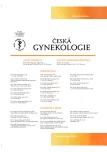
2020 Issue 1-
All articles in this issue
- Assisted reproduction trends in Czech Republic National Assisted Reproduction Register 2007–2017
- Transabdominal punction of follicular fluid in IVF cyclus in a patient after ovarian transposition
- Bilateral simultaneous tubal pregnancy
- Thrombotic microangiopathy and pregnancy
- Severe thrombotic microangiopathy accompanied by liver rupture and multiorgan failure at week 26 of pregnancy
- Echinococcosis with the image of peritoneal carcinomatosis
- Lactobacillus crispatus dominant vaginal microbita in pregnancy
- The effects of prenatal, perinatal and neonatal factors on academic performance in primary school age children
- Noninvasive prenatal testing: benefits and limitations of the available tests
- Can we prevent ovarian cancer?
- Patients experiences after hospitalization at Gynecologic Obstetrics Department: Identifying parts for improvement
- Czech Gynaecology
- Journal archive
- Current issue
- Online only
- About the journal
Most read in this issue- Thrombotic microangiopathy and pregnancy
- Lactobacillus crispatus dominant vaginal microbita in pregnancy
- Noninvasive prenatal testing: benefits and limitations of the available tests
- Can we prevent ovarian cancer?
Login#ADS_BOTTOM_SCRIPTS#Forgotten passwordEnter the email address that you registered with. We will send you instructions on how to set a new password.
- Career




